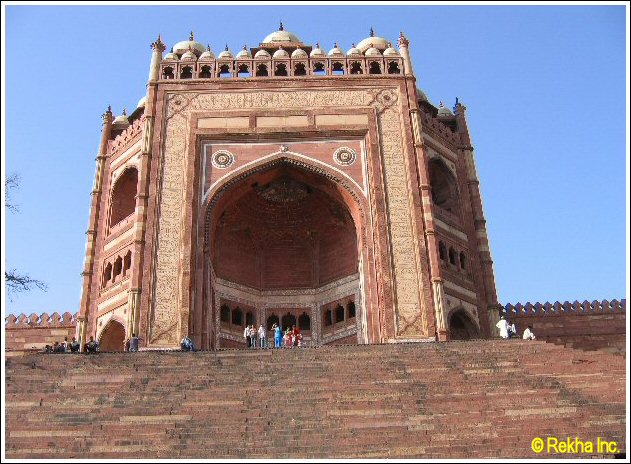Search India Agra Pictures

|
Search India Agra Pictures |
 |
| Search India Home | Fatehpur Sikri, Agra |
|
Agra Fast Food Vendor Agra Fort - 1 Agra Fort - 2 |
Agra Street Scene Fatehpur Sikri - 1 Fatehpur Sikri - 2 |
Hot Jalebi Vendor Ram Leela Sikandra |
Taj Mahal - 1 Taj Mahal - 2 Taj Mahal - 3 |
 Buland Darwaza at Fatehpur Sikri, Agra Fatehpur Sikri's main entrance is a lofty gate called Buland Darwaza. The Darwaza is 40 metres high and topped by pillars and chhatris. Buland Darwaza is considered to be the greatest architectural monument of Akbar's long reign. The Darwaza was built by Akbar in 1573 to commemorate the conquest of Gujarat. Sufi saint Sheikh Salim Chishti, who lived in the village of Sikri near Agra, predicted that Akbar would have three sons. As per the prediction, one of the Rajput queens of Akbar - Maryam Zamani or Mary of the Age - gave birth to a son in 1569 and was named as Salim after the Saint. Subsequently, Akbar was blessed with two more sons. Akbar built the city of Fatehpur Sikri to show his gratitude to the Sufi saint Sheikh Salim Chishti and to celebrate his victory in Gujarat. Located at a distance of about 37 kms from Agra, this hill-top city was built with red sandstone. The city is divided into royal and spiritual enclosures. The royal enclosure comprises of nine palaces, the harem and official buildings. The nine palaces are Ankh Michauli, Diwan I Khas, Astrologer's Seat, Panch Mahal, Girl's School, Turkish Sultana, Anup Talao, Khwabgah and Diwan I Am. The spiritual enclosure consists of dargah of Sufi Saint Sheikh Salmi Chishti and a congregational mosque Jami Masjid. Buland Darwaza is situated to the left of the Dargha complex while the tomb of Sheikh Salim Chishti is on the right side. After nearly fourteen years of occupation, Akbar moved away from Fatehpur Sikri in 1585. The Mughal seat of power was moved to Lahore and subsequently to Agra. Fatehpur Sikri never again was a capital city of Mughal empire. Speculation has it that Akbar moved away from the City of Victory due to water supply issues. The other theory was that the third Mughal Emperor moved north to Lahore and then to other capital cities to handle a threat to his empire. The city bears a distinct style of architecture with a fusion of Islamic and Hindu elements. Akbar is believed to have used Hindu craftsman from Gujarat in building Fatehpur Sikri |